Nano-Magnesium Silicate Hydroxide/Crumpled Graphene Balls Composites, a Novel Kind of Lubricating Additive with High Performance for Friction and Wear Reduction
Abstract
:1. Introduction
2. Materials and Methods
2.1. Materials
2.2. Preparation of CGB and Nano-MSH
2.3. Preparation and Modification of Nano-MSH/CGB Composites
2.4. Preparation of ML-MSH/CGB Oil
2.5. Tribological Properties and Structural Characterization of ML-MSH/CGB Composites as Oil Additive
2.6. The Measurement of Wear Scar Diameter (WSD) and Wearing Capacity (WC)
3. Results and Discussion
3.1. Structure and Morphology
3.2. Tribological Properties of ML-MSH/CGB in Base Oil
4. Conclusions
Supplementary Materials
Author Contributions
Funding
Conflicts of Interest
References
- Holmberg, K.; Andersson, P.; Erdemir, A. Global energy consumption due to friction in passenger cars. Tribol. Int. 2012, 47, 221–234. [Google Scholar] [CrossRef]
- Qu, J.; Barnhill, W.C.; Luo, H.; Meyer, H.M.I.; Leonard, D.N.; Landauer, A.K. Synergistic effects between phosphonium-alkylphosphate ionic liquids and zinc dialkyldithiophosphate (ZDDP) as lubricant additives. Adv. Mater. 2015, 27, 4767–4774. [Google Scholar] [CrossRef] [PubMed]
- Han, H.R.; Cho, J.E.; Sim, D.S.; Kang, C.H.; Kim, Y.W.; Jeong, N.H. A study on dimethacryloyloxy alkane derivatives having an anti-wear performance as lubricating oil additives. Korean J. Chem. Eng. 2016, 27, 583–589. [Google Scholar]
- Morina, A.; Neville, A.; Priest, M.; Green, J.H. ZDDP and MoDTC interactions and their effect on tribological performance-tribofilm characteristics and its evolution. Tribol. Lett. 2006, 24, 243–256. [Google Scholar] [CrossRef]
- Wang, J.; Liu, Y.; Duan, D.; Li, S. Comparative Study on the Tribological Performances of Barium Perrhenate, Molybdenum Disulfide, and Calcium Carbonate as Lubricant Additives in a Wide Temperature Range. Tribol. Trans. 2015, 59, 139–148. [Google Scholar] [CrossRef]
- Esquivel-Gaon, M.; Nguyen, N.H.; Sgroi, M.F.; Pullini, D.; Gili, F.; Mangherini, D.; Pruna, A.L.; Rosicka, P.; Sevcu, A.; Castagnola, V. In vitro and environmental toxicity of reduced graphene oxide as an additive in automotive lubricants. Nanoscale 2018, 10, 6539–6548. [Google Scholar] [CrossRef] [Green Version]
- Li, J.; Hao, L.; Xu, X.; Ren, T. Tribological synergism of surface-modified calcium borate nanoparticles and sulfurized olefin. Ind. Lubr. 2012, 64, 217–223. [Google Scholar] [CrossRef]
- Zhang, X.F.; Li, K.W.; Zhou, Y.; Cheng, X.N. In situ synthesis and tribological behavior of copper nanopieces in liquid paraffin as additive in mobil 1 5w-30 lubricating oil. Adv. Mater. Res. 2013, 669, 349–354. [Google Scholar] [CrossRef]
- Zhao, G.; Zhao, Q.; Li, W.; Wang, X.; Liu, W. Tribological properties of nano-calcium borate as lithium grease additive. Lubr. Sci. 2014, 26, 43–53. [Google Scholar] [CrossRef]
- Zeng, X.Q.; Shao, H.Y.; Rao, W.Q.; He, Z.Y.; Ren, T.H. Tribological study of trioctylthiotriazine derivative as lubricating oil additive. Wear 2005, 258, 800–805. [Google Scholar]
- Lonkar, S.P.; Deshmukh, Y.S.; Abdala, A.A. Recent advances in chemical modifications of graphene. Nano Res. 2015, 8, 1039–1074. [Google Scholar] [CrossRef]
- Lin, J.S.; Wang, L.W.; Chen, G.H. Modification of graphene platelets and their tribological properties as a lubricant additive. Tribol. Lett. 2011, 41, 209–215. [Google Scholar] [CrossRef]
- Jia, Z.; Pang, X.; Li, H.; Ni, J.; Shao, X. Synthesis and wear behavior of oleic acid capped calcium borate/graphene oxide composites. Tribol. Int. 2015, 90, 240–247. [Google Scholar] [CrossRef]
- Ren, G.; Zhang, Z.; Zhu, X.; Ge, B.; Guo, F.; Men, X.; Liu, W. Influence of functional graphene as filler on the tribological behaviors of Nomex fabric/phenolic composite. Compos. Part A 2013, 49, 157–164. [Google Scholar] [CrossRef]
- Prashantha Kumar, H.G.; Anthony Xavior, M. Effect of graphene addition and tribological performance of Al 6061/graphene flake composite. Tribol. Mater. Surf. Int. 2017, 11, 88–97. [Google Scholar] [CrossRef]
- Xie, F.; Ge, S.R.; Li, X.N.; Hao, J.T. Influence of surfactants on the dispersion stability of nano-graphite in the lubricating oil. Lubr. Eng. 2012, 4, 1–5. [Google Scholar]
- Senatore, A.; D’Agostino, V.; Petrone, V.; Ciambelli, P.; Sarno, M. Graphene oxide nanosheets as effective friction modifier for oil lubricant: Materials, methods, and tribological results. ISRN. Tribol. 2013, 2013, 1–9. [Google Scholar] [CrossRef] [Green Version]
- Luo, J.; Kim, J.; Huang, J. Material processing of chemically modified graphene: Some challenges and solutions. Acc. Chem. Res. 2013, 46, 2225–2234. [Google Scholar] [CrossRef]
- Luo, J.; Jang, H.D.; Sun, T.; Xiao, L.; He, Z.; Katsoulidis, A.P.; Kanatzidis, M.G.; Gibson, J.M.; Huang, J. Compression and aggregation-resistant particles of crumpled soft sheets. ACS Nano 2011, 5, 8943–8949. [Google Scholar] [CrossRef]
- Luo, J.; Jang, H.D.; Huang, J. Effect of sheet morphology on the scalability of graphene-based ultracapacitors. ACS Nano 2013, 7, 1464–1471. [Google Scholar] [CrossRef]
- Song, H.J.; Jia, X.H.; Li, N.; Yang, X.F.; Tang, H. Synthesis of α-Fe2O3 nanorod/graphene oxide composites and their tribological properties. J. Mater. Chem. 2012, 22, 895–902. [Google Scholar] [CrossRef]
- Dou, X.; Koltonow, A.R.; He, X.; Jang, H.D.; Wang, Q.; Chung, Y.; Huang, J. Self-dispersed crumpled graphene balls in oil for friction and wear reduction. Proc. Natl. Acad. Sci. USA 2016, 113, 1528–1533. [Google Scholar] [CrossRef] [PubMed] [Green Version]
- Berman, D.; Deshmukh, S.A.; Sankaranarayanan, S.K.R.S.; Erdemie, A.; Sumant, A.V. Friction macroscale superlubricity enabled by graphene nanoscroll formation. Science 2015, 348, 1118–1122. [Google Scholar] [CrossRef] [PubMed] [Green Version]
- He, K.J.; Liu, J.; Lv, H.; Zheng, S.M.; Wang, K.M. The preparation and tribological property investigation of chrysotile nanotubes on the grease. Appl. Mech. Mater. 2013, 395, 149–153. [Google Scholar] [CrossRef]
- Wang, B.; Chang, Q.; Gao, K.; Fang, H.R.; Qing, T.; Zhou, N.N. The synthesis of magnesium silicate hydroxide with different morphologies and the comparison of their tribological properties. Tribol. Int. 2018, 119, 672–679. [Google Scholar] [CrossRef]
- Shen, J.; Hu, Y.; Shi, M.; Lu, X.; Qin, C.; Li, C.; Ye, M. Fast and facile preparation of graphene oxide and reduced graphene oxide nanoplatelets. Chem. Mater. 2009, 21, 3514–3520. [Google Scholar] [CrossRef]
- Zhang, W.; He, W.; Jing, X. Preparation of a stable graphene dispersion with high concentration by ultrasound. J. Phys. Chem. B 2010, 114, 10368–10373. [Google Scholar] [CrossRef]
- Ma, X.; Zachariah, M.R.; Zangmeister, C.D. Crumpled nanopaper from graphene oxide. Nano Lett. 2012, 12, 486–489. [Google Scholar] [CrossRef]
- Mao, S.; Wen, Z.; Kim, H.; Lu, G.; Hurley, P.T.; Chen, J. A General approach to one-pot fabrication of crumpled graphene-based nanohybrids for energy applications. ACS Nano 2012, 6, 7505–7513. [Google Scholar] [CrossRef]
- Li, S.J.; Huang, H.Y.; Yang, X.X.; Wang, C.G.; Kobayashi, N.; Kubota, M. A facile method to construct graphene oxide–based magnesium hydroxide for chemical heat storage. Nanosc. Microsc. Therm. Eng. 2017, 21, 1–7. [Google Scholar] [CrossRef]
- Anbalagan, G.; Sivakumar, G.; Prabakaran, A.R.; Gunasekaran, S. Spectroscopic characterization of natural chrysotile. Vib. Spectrosc. 2010, 52, 122–127. [Google Scholar] [CrossRef]
- Wang, H.; Qian, S.; Huang, C.; Zhao, Y. Experimental investigation on the lubrication properties of castor oil affected by graphene as lubricant additives. Lubr. Eng. 2017, 42, 48–52. [Google Scholar]
- Jiang, Y.; Lin, R.; Zhang, T. Synthesis and characterizations of linear alkyl modified hydrophobic graphene oxide. J. Funct. Mater. 2017, 48, 10013–10016. [Google Scholar]

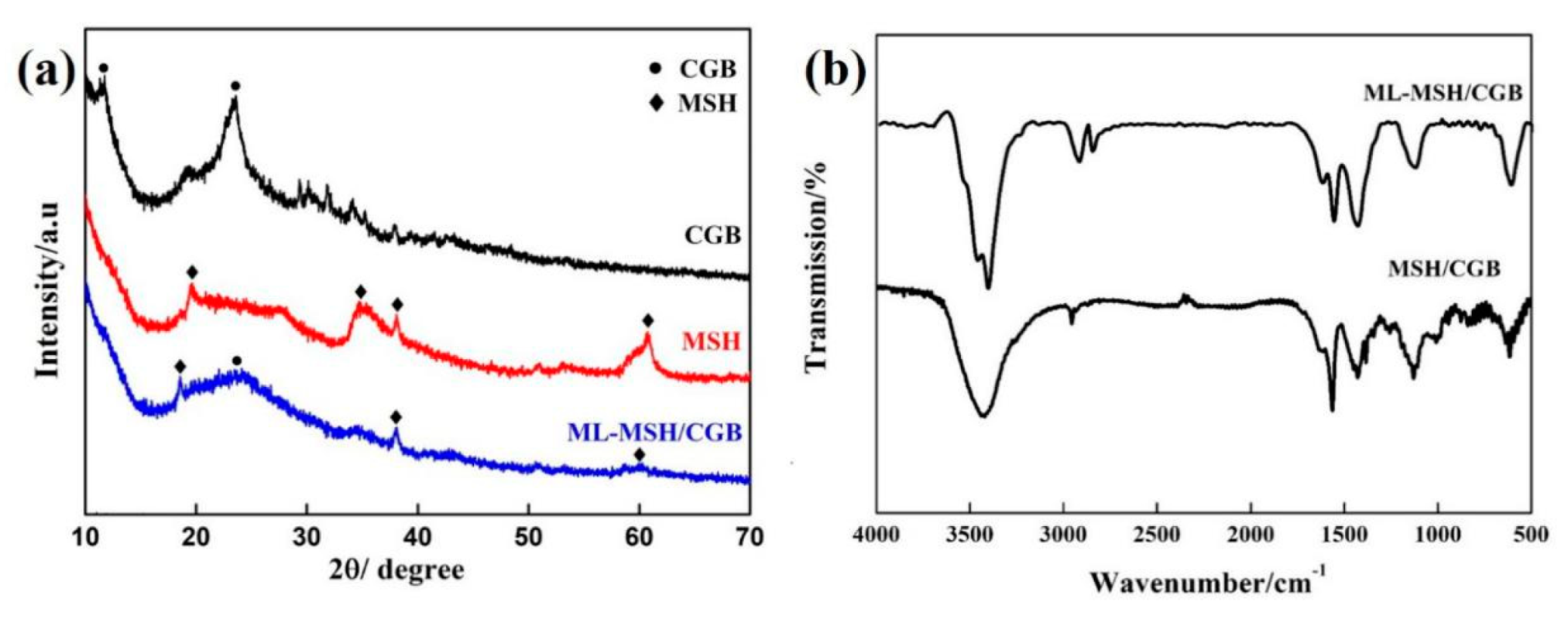
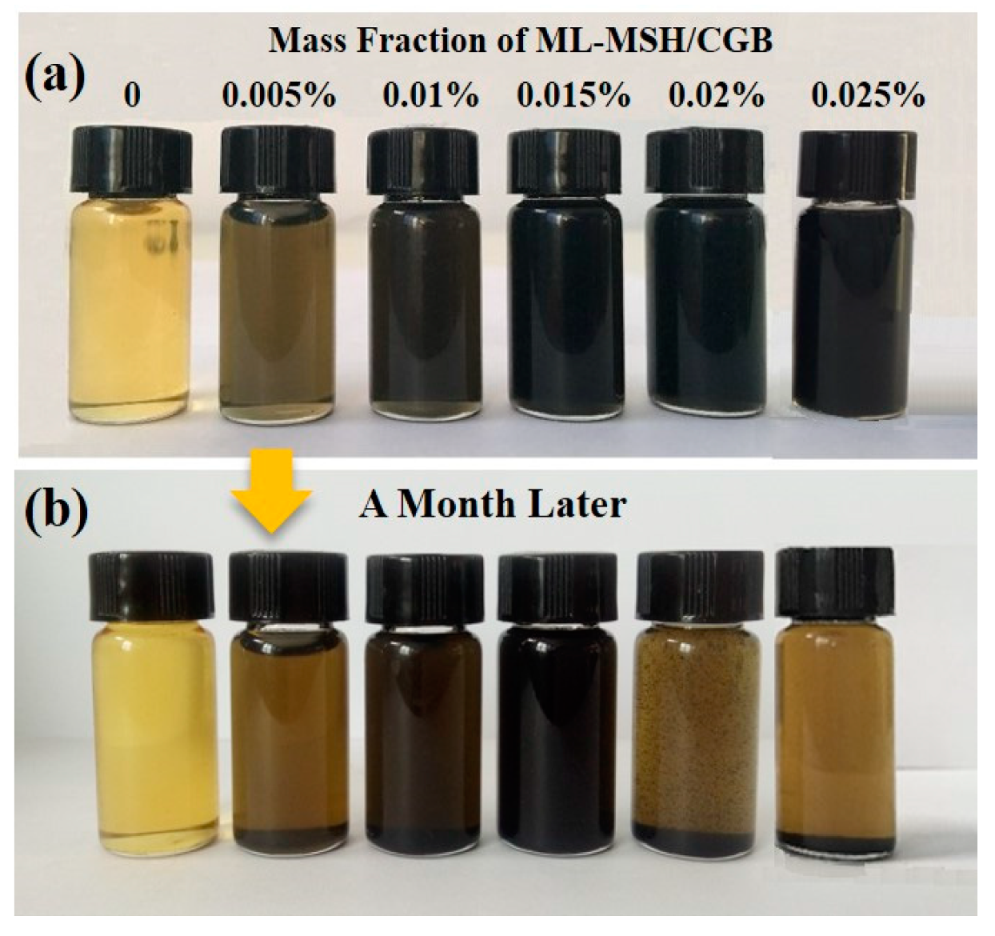
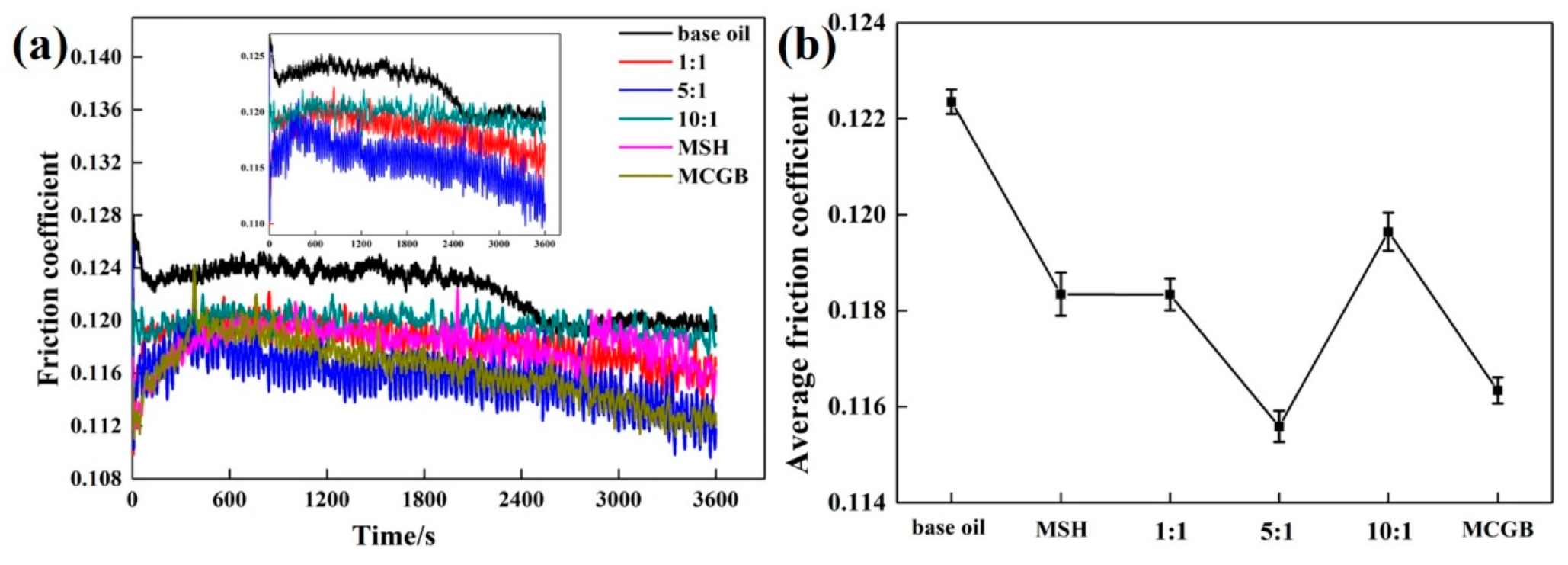

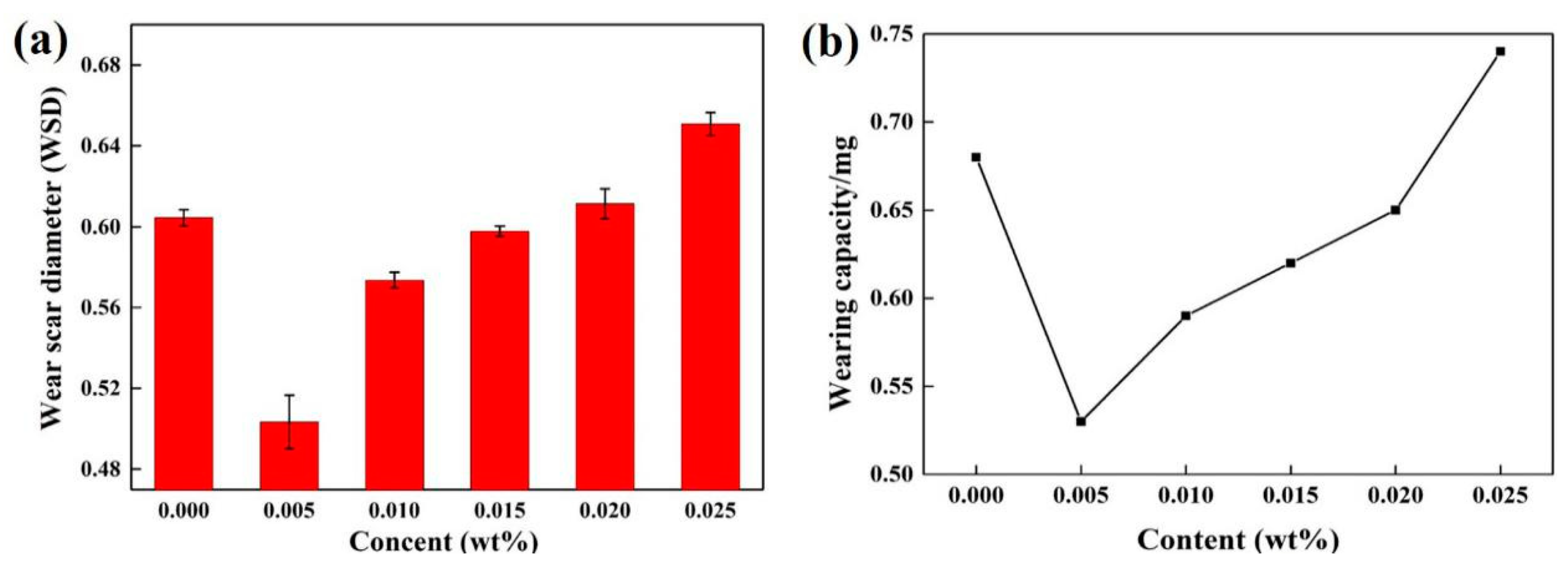
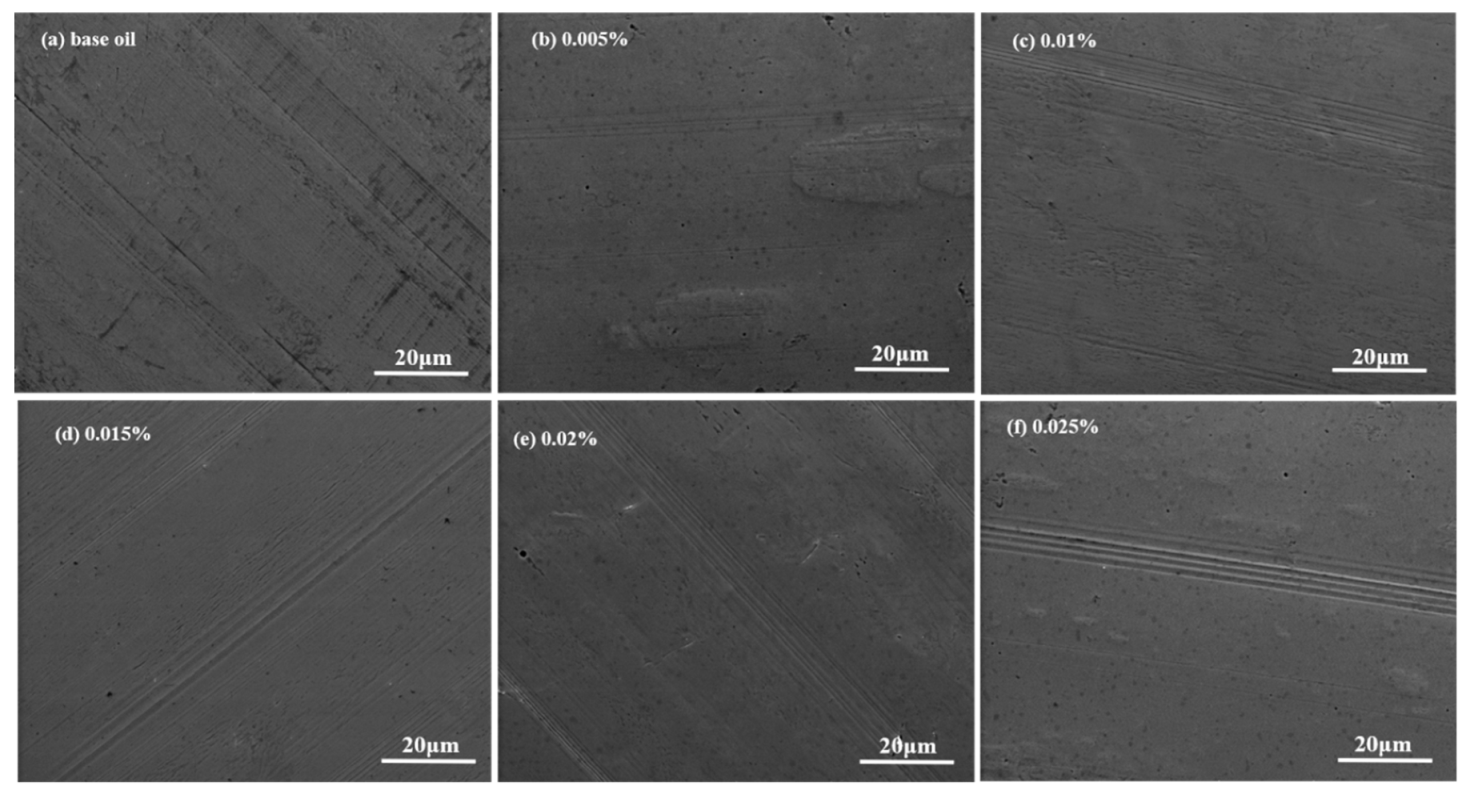


© 2020 by the authors. Licensee MDPI, Basel, Switzerland. This article is an open access article distributed under the terms and conditions of the Creative Commons Attribution (CC BY) license (http://creativecommons.org/licenses/by/4.0/).
Share and Cite
Zhang, T.; Zhao, J.; Zhang, J.; Zhang, S.; Li, J.; Li, S.; Li, X.; Zhang, J. Nano-Magnesium Silicate Hydroxide/Crumpled Graphene Balls Composites, a Novel Kind of Lubricating Additive with High Performance for Friction and Wear Reduction. Materials 2020, 13, 3669. https://doi.org/10.3390/ma13173669
Zhang T, Zhao J, Zhang J, Zhang S, Li J, Li S, Li X, Zhang J. Nano-Magnesium Silicate Hydroxide/Crumpled Graphene Balls Composites, a Novel Kind of Lubricating Additive with High Performance for Friction and Wear Reduction. Materials. 2020; 13(17):3669. https://doi.org/10.3390/ma13173669
Chicago/Turabian StyleZhang, Tong, Jianguo Zhao, Jin Zhang, Shanshan Zhang, Jingwei Li, Shijie Li, Xinyu Li, and Jie Zhang. 2020. "Nano-Magnesium Silicate Hydroxide/Crumpled Graphene Balls Composites, a Novel Kind of Lubricating Additive with High Performance for Friction and Wear Reduction" Materials 13, no. 17: 3669. https://doi.org/10.3390/ma13173669





